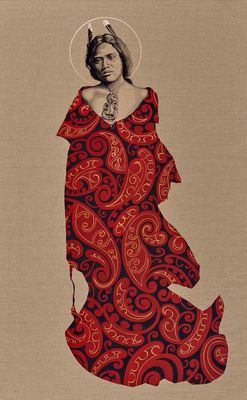
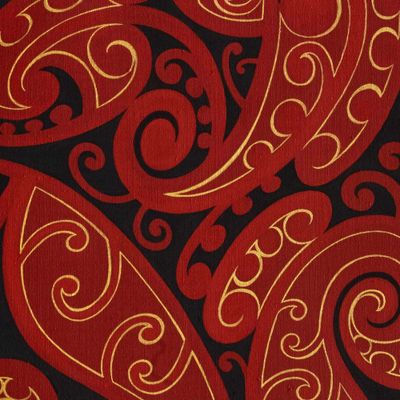
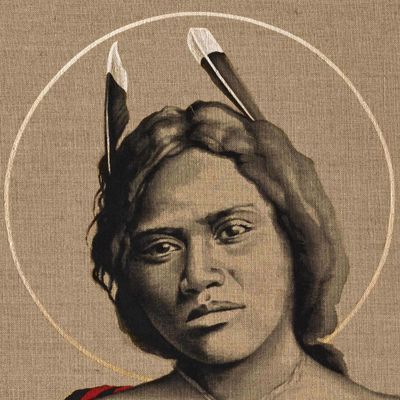
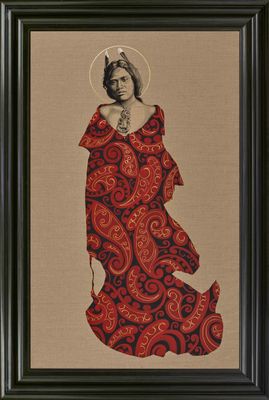
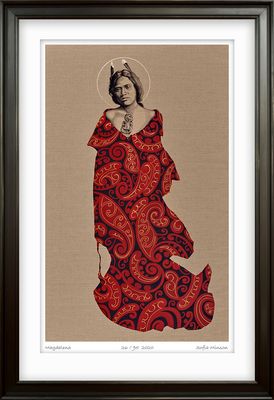

Magdalena
$2,000.00
Explore the story of the artwork >>
Print sizes and editions
- Regular museum archival paper print - 810 x 501mm
(limited to 95) - Large museum archival paper print - 1152 x 712mm
(limited to 95) - Extra Large museum canvas print - 1361 x 840mm
(limited to 95)
Your unique limited edition fine art print
- Sofia Minson creates your exclusive signed print
- We ship for $25 in NZ and from $50 internationally
- Your artwork arrives rolled, ready to be framed - do you need help? Request framing guidance
Original painting SOLD, flashe on raw linen, 1900 x 1280mm (including frame), 2018
The story of Magdalena
Magdalena is a cross-cultural goddess. She is Gnostic Christianity's Sophia and Mary Magdalene, ancient Egypt's Isis, and Māori myth's Hine-tītama.
All of these atua wāhine or divine feminine forces are linked with a masculine element. Sophia with Christ, Mary with Jesus, Isis with Osiris and Hine-tītama with Tāne (progenitor of mankind). They each undergo a period of suffering for the loss of that male counterpart.
The myth of the female divinity mourning a slain god and seeking his body for anointing is as old as human time.
The Christian goddess hidden in plain sight
Patriarchal Christianity held sway in the Western world for centuries and veneration of Sophia was forced underground. But the Christian goddess has always been right before our eyes, hiding in plain sight. Mary Magdalene anointed Jesus, and when he was crucified, she was the first disciple to witness his resurrection.
Those who wrote the first gospels, both canonical and Gnostic, gave the name Yeshu (Jesus) to Christ and the name Mary Magdalene to Sophia.
The divine feminine
Mary Magdalene is Sophia, who is wisdom, who is the divine feminine, who is God manifest. God is Source and the Goddess is the emanation or the play of God. In other words, the Goddess is the world.
Sophia's story is a parable for the plight of the lost human soul seeking Gnosis, or God-consciousness. Sophia is the soul. Christ is that which enlightens the soul.
Sophia in Egyptian and Māori myth
In Egypt, Isis was a form of Sophia. When great king Osiris was murdered by his brother Set, his body was cut into many pieces and scattered throughout the land. Isis, the queen of the underworld, found Osiris' phallus. She impregnated herself, giving birth to Horus, who was a messianic figure like Jesus.
In Māori myth, Tāne-mahuta betrayed Hine-tītama, the young Lady of the Dawn. He slept with her without telling her that he was her father. When she realised the truth she fled to the underworld of chaos and potentially. She became Hine-nui-te-pō, the Great Woman of the Night. She welcomes her human children as they pass through death into the next realm.
Halo, feathers, heitiki and korowai
The heitiki pounamu pendant Magdalena wears in this painting, symbolises her male consort.
Her halo is her divinity, transitioning from metallic gold to luminous white.
The white tipped huia feathers indicate ascension. Manu Huia travelled through the twelve heavens from the uppermost, to our earthly realm, and back again. He was charged with delivering a message to Tāne, that it was time for him to come and receive the baskets of knowledge.
Magdalena's dress is a stylised korowai (Māori cloak) with an Asian influence. I was drawn to Japanese, Chinese and Korean portrait paintings. The women wear flowing gowns that create interesting shapes against simple backgrounds.
Creation and manifestation
The black, red and gold koru patterns symbolise the unfolding dance of creation. The black is Te Kore, The Void, which is unlimited potential for being. The red is manifestation, it is the female blood of childbirth and creation of the material world. The gold is luminous spirit, it is celestial yang (masculine) light.
The branching koru remind me of fractal patterns. Fractals are formed by chaotic yet simple mathematical equations. As you zoom in, they endlessly unfold reduced-sized versions of the whole. From snowflakes to mountain ranges, fractal patterns are all around us in nature. They visually express the Hermetic phrase "As Above, So Below." This idea points to universes existing within universes, and consciousness infinitely bubbling into consciousness.
The Myth of Sophia:
In the beginning was pure unmanifest consciousness and it was aware. Gnostics called it All That Is. With neither gender nor form, All That Is emanated pairs of Aeons to play various roles in creation.
Sophia was the original female principal. She found herself separated from Source and grew fearful. She felt exiled, lost in this lesser place. Wandering through the world of matter created by her own fear and confusion, Sophia suffered. She was a "fallen woman" for years beyond counting, longing to return to All That Is.
Rescued from the physical world
Eventually, All That Is took pity on her and sent out her other half, so that she might once again see the light. As her paired Aeon and saviour, Christ rescued her from the physical world. He gathered her up into Gnosis (knowledge of the divine) so that she remembered herself.
Sophia's story is our own mortal tale. We seem doomed to wander alone through the world of matter. We don't know where we're going, why we're here or who we are. We're afraid and push ourselves further into matter to escape the aching feeling that we have lost our home.
We are not alone in our suffering
The Goddess Sophia not only created matter, she lived in it to show us we are not alone in our suffering. Christ, her partner and equal, is Gnosis, who comes if we call.
Sofia Minson Paintings | New Zealand Artwork

